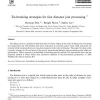Free Online Productivity Tools
i2Speak
i2Symbol
i2OCR
iTex2Img
iWeb2Print
iWeb2Shot
i2Type
iPdf2Split
iPdf2Merge
i2Bopomofo
i2Arabic
i2Style
i2Image
i2PDF
iLatex2Rtf
Sci2ools
DKE
2002
2002
Tie-breaking strategies for fast distance join processing
The distance join is a spatial join that finds pairs of closest objects in the order of distance by associating two spatial data sets. The distance join stores node pairs in a priority queue, from which node pairs are retrieved while traversing R-trees in top-down manners in the order of distance. This paper first shows that a priority strategy for the tied pairs in the priority queue during distance join processing greatly affects its performance. Then it proposes a probabilistic tie-breaking priority method. The experiments show that the proposed method is always better than alternative methods in the performance perspectives.
| Added | 18 Dec 2010 |
| Updated | 18 Dec 2010 |
| Type | Journal |
| Year | 2002 |
| Where | DKE |
| Authors | Hyoseop Shin, Bongki Moon, Sukho Lee |
Comments (0)

